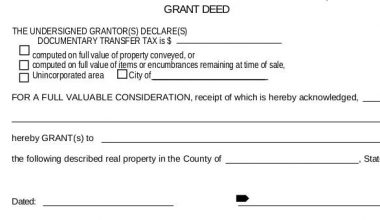Mortgage-backed securities (MBS) could be a smart choice to examine if you’re looking for ways to diversify your portfolio. Mortgage-backed securities are a collection of mortgages purchased from the banks that produced them and then sold to investors at varying interest rates. An MBS allows investors to benefit from the mortgage market without needing to buy or sell house loans directly. If you want to discover more about mortgage-backed securities, keep reading as we’ve covered several securities such as residential mortgages and commercial property, as well as popular MBS ETF to consider.
What are Mortgage-Backed Securities?
Mortgage-backed securities (MBS) is a type of financial instrument that is backed by a mortgage or a group of mortgages. An MBS is an asset-backed instrument that carries out exchange on the secondary market and allows investors to profit from the mortgage industry without having to buy or sell house loans directly.
Mortgages are sold to organizations such as investment banks or government agencies, who bundle them into MBSs that can be sold to individual investors. An MBS mortgage must have originated from a licensed financial institution.
An investor who purchases a mortgage-backed asset is essentially lending money to home buyers. In exchange, the investor receives the right to the mortgage’s value, including the borrower’s interest and principal payments.
Selling mortgages allows banks to offer mortgages to customers with less concern about the borrower’s ability to repay the loan. The bank operates as a go-between for MBS investors and home buyers. Individual investors, companies, and institutional investors are common buyers of MBS.
History of MBS
Following the passing of the Housing and Urban Development Act in 1968, mortgage-backed securities came into existence. The act established the Government National Mortgage Association, or Ginnie Mae, as a separate entity from Fannie Mae.
The new entity allowed banks to sell their mortgages to third parties in order to free up funds for lending and loan origination. As a result, institutional funds were able to purchase and package a large number of loans into an MBS.
Ginnie Mae provided the first mortgage-backed securities for the retail housing sector in 1970. Bank of America issued the first private MBS in 1977.
How do mortgage-backed securities work?
Mortgage-backed securities are a collection of mortgages that have been set, to pay out interest in the manner of bonds. Aggregators, which include institutions such as Fannie Mae and Freddie Mac, create MBSs. They acquire loans from lenders, particularly large banks, and package them into mortgage-backed securities.
While we all grew up believing that banks made loans and then held them until they matured, the reality is that your lender is likely selling the loan into what is known as the secondary mortgage market. Aggregators acquire and sell mortgages, searching for the best mortgages for the securities they wish to produce and offer to investors. This is the most prevalent reason for a borrower’s mortgage loan servicer to switch after obtaining a mortgage loan.
Consider a mortgage-backed securities to be a massive pie that contains thousands of mortgages. The MBS designers may break this pie into potentially millions of slices, each with a little piece of each mortgage, to provide investors with the desired level of return and risk.
The aggregators can make a variety of bond slices from the pool of mortgages. The risk and return profiles of the borrowers on the other end of the mortgages are related. On the residential side, for example, stable earners with consistent income histories and strong credit scores typically receive a lower interest rate on their mortgage than borrowers who lenders consider to be a greater risk and hence have a higher interest rate on their loan. The interest rate indicates the return on mortgage-backed securities and is usually adjusted for changes in interest rates and the risk of default in the mortgage portfolio.
Mortgage-backed securities, like the mortgages that underpin them, often pay out to investors on a monthly basis. But, unlike a normal bond, which pays interest and then returns your principal, an MBS may pay both principal and interest over the life of the security, so there will be no lump-sum payment at the end of the MBS’s existence.
Types of mortgage-backed securities
Mortgage-backed securities can have a variety of features based on market demand. MBS developers consider their pool of mortgages to be streams of cash flow that can last 10, 15, or 30 years — the normal length of a mortgage. Yet, the underlying loans of the bond may be refinanced, and investors are refunded their principle while losing the cash flow over time.
Aggregators can produce bonds with specific degrees of risk or other characteristics by seeing mortgage features as a stream of risks and cash flows. These securities can be based on either home mortgages (residential mortgage-backed securities) or commercial property loans (commercial mortgage-backed securities).
Mortgage-backed securities are classified according to their structure and complexity, and they include:
#1. Pass-through Securities
A trust holds numerous mortgages and distributes mortgage payments to its many investors based on the percentage of the securities they possess. Its structure is easy to understand.
#2. Collateralized Mortgage Obligation (CMO)
A CMO is a legal structure that is under the protection of the mortgages it holds, but it has a twist. Consider the pie metaphor once more. A CMO can construct different classes of securities with varying risks and returns from a given pool of mortgages. It can, for example, construct a safe class of bonds that are paid before other types of bonds. The final and riskiest class is paid out only if all of the preceding classes are paid.
#3. Stripped Mortgage-backed Securities (SMBS)
This type of asset divides the mortgage payment into two parts: principle repayment and interest payment. Investors can then purchase either the security-paying the principle (which pays out less at first but appreciates over time) or the security-paying interest (which pays out more but declines over time).
These arrangements enable investors to participate in mortgage-backed securities while assuming certain risks and benefits. For example, an investor could purchase a relatively safe slice of a CMO with a high possibility of repayment at the expense of a lower overall return.
How do mortgage-backed securities affect mortgage rates?
Residential mortgage rates are directly affected by the cost of mortgage-backed securities. This is because mortgage companies lose money when they provide loans during a weak market.
When the value of mortgage-backed securities falls, mortgage lenders typically raise interest rates. Mortgage lenders, on the other hand, cut interest rates when the price of mortgage-backed securities rises.
The Pros And Cons Of Investing In Mortgage-Backed Securities
Investing in MBSs has advantages and disadvantages that vary according on the security and company in which you invest.
When investing in an MBS, be sure the investment asset meets your personal goals and risk tolerance. Here’s a rundown of some of the benefits and drawbacks of investing in these assets.
Pros Of Mortgage-Backed Securities
Here are some of the most significant benefits of investing in an MBS:
- Safe investment: MBSs are a relatively safe investment because they are typically fixed-rate loans with prepayment penalties.
- Attractive yields: MBSs often have rates that are greater than those found in US government bonds. Stocks with greater coupons provide the most potential profits.
- Minimal credit risk: Credit risk is regarded as modest for MBSs backed by government-sponsored organizations.
Cons Of Mortgage-Backed Securities
Here are some of the disadvantages of investing in an MBS:
- Prepayment risk: There is always the possibility that borrowers will make higher-than-anticipated monthly payments or pay off their mortgage sooner than expected. They could also refinance and pay off the mortgage, which is more common when interest rates fall.
- Interest rate risk: MBSs have a higher interest rate risk because the security’s price can fall as interest rates rise.
- Credit and default risk: Investors will suffer losses if the borrowers fail to make their interest and principal payments. The level of risk is determined by the strength of the market and the date the loan was provided.
- Extension risk: There is also the possibility that borrowers will decide not to make the anticipated mortgage prepayments. Because the principal is lower in this case, the security may have a lower-than-expected coupon. This is common when Treasury rates begin to rise.
Mortgage-Backed Securities Today
Mortgage-backed securities are still purchased and sold. People will pay their mortgages if they can, therefore there is a market for them again. The Fed still controls a sizable portion of the MBS market, although it is steadily reducing its holdings.
Even CDOs have made a comeback after falling out of favor for a few years following the crisis. The presumption is that Wall Street has learned its lesson and will reconsider the worth of MBSs rather than blindly purchasing them. Only time will tell.
Top 3 Mortgage-Backed Securities (MBS) ETF
A mortgage-backed security exchange-traded fund (ETF) is a portfolio of mortgage-backed securities. The fund is then traded on an exchange, giving investors exposure to bundles of mortgage-backed securities rather than individual MBSs.
When interest rates are low throughout the economy, demand for mortgage loans normally increases. This rise in asset-based securities often leads to an increase in the pool of high-quality assets in this investment category. Fixed-income investors seeking greater returns than US Treasuries may consider investing in a mortgage-backed securities exchange-traded fund (ETF) (MBS).
Let’s look at some popular mortgage-backed securities ETF that investors may choose while interest rates are low:
#1. The iShares MBS Bond ETF
The iShares MBS Bond ETF (MBB) is an excellent choice for investors interested in investing in fixed-rate mortgage pass-through securities issued by the Federal National Mortgage Association (FNMA), the Government National Mortgage Association (GNMA), and the Federal Home Loan Mortgage Corporation (FHLMC).
The fund’s goal is to deliver returns that correspond to the performance of its benchmark, the Bloomberg U.S. MBS Index. The fund’s holdings are primarily composed of 30-year fixed-rate mortgages.
#2. The SPDR Portfolio Mortgage-Backed Bond ETF
The SPDR Portfolio Mortgage-Backed Bond ETF (SPMB) is comparable to its predecessor. It also aims to mimic the price and yield performance of the Bloomberg U.S. MBS Index by investing in FNMA, GNMA, and FHLMC assets.
#3. The Vanguard Mortgage-Backed Securities ETF
The Vanguard Mortgage-Backed Securities ETF (VMBS) tries to replicate the performance of the Bloomberg US Mortgage-Backed Securities Float Adjusted Index. With a dollar-weighted average maturity of three to ten years, the fund carries moderate interest rate risk.
What is mortgage-backed securities example?
So Peter goes to a bank to try to get a loan. Peter’s credit score undergoes a series of examinations by the bank. He secured the loan with a 20% down payment without much difficulty. It is a portion of the total purchase price of the asset and is paid for with cash, bank check, credit card, or online banking.
What do mortgage-backed securities do?
MBS transforms a bank into a go-between for the homebuyer and the investing industry. The bank manages the loans before selling them at a loss to investors as MBSs, a sort of collateralized bond.
Why did investors buy mortgage-backed securities?
MBS often have greater yields than government bonds. Assets with larger coupons have the potential for higher returns, but they come with heightened credit and prepayment risk, which means the realized yield may be lower than planned.
Who owns mortgage-backed securities?
The Government National Mortgage Association (Ginnie Mae), a US government agency, or the Federal National Mortgage Association (Fannie Mae) and the Federal Home Loan Mortgage Corporation (Freddie Mac), both US government-sponsored firms, issue the majority of mortgage-backed securities.
What is the difference between CMO and MBS?
A collateralized mortgage obligation, or CMO, is a type of MBS in which mortgages are bundled and marketed as a single investment based on term and risk level. A mortgage-backed security, or MBS, is a type of asset-backed instrument in which the amount of interest in a pool of mortgage loans is always out in the open.
In conclusion
Mortgage-backed securities have changed dramatically throughout the years. MBSs are a considerably safer investment today than they were in the past, thanks to enhanced financial industry regulation.
Unfortunately, there is no such thing as a risk-free investment. Before you invest in any asset, you should always be aware of the potential risks and rewards.
Related Articles
- Real Estate Industry: Overview, Types & Examples
- Secured Bonds: The Ultimate Guide
- Bespoke Tranche Opportunities 2023: Definition & All You Need to Know
- CMO (Chief Marketing Officer): Definition, Job Description, Skills, Salary
- MANAGEMENT TEAM: Company Management Team Tasks






